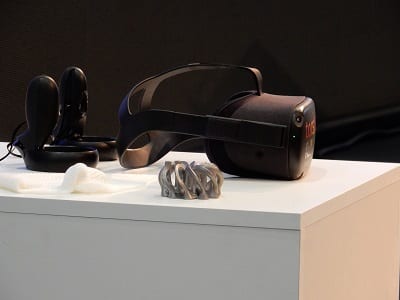by Daniel Martin
Organizations are looking for ways to develop a more collaborative and engaged workforce. But that has not been easy with the business world expanding and people working remotely. Companies have been exploring video chats and conference calls as solutions to keep their remote workers engaged.
These technologies have been helping businesses achieve their goals but with some limitations. It has been difficult for companies to replicate real-life experiences with video chats and conference calls. Virtual reality technology has transformed how these businesses hold meetings with employees and customers.
Virtual reality technology makes people feel like they are in the same room. This is one of the reasons why VR has earned a reputation worldwide, even before becoming mainstream. Experts now predict that the VR industry will grow to a $56.25 billion industry by 2025. This article looks into how VR will improve business meetings.
Here are some of the ways.
Make It Easy to Attend Regional Meetings from Home
You will no longer need to commute to attend a meeting somewhere. Virtual reality technology is making it easy to do so from your living room. You will only need a virtual reality headset and software that enables it to work and attend the meeting from the comfort of your home.
The best thing about virtual reality is the experience it brings. You will not be watching your colleagues on a screen but be in the same virtual environment with them. This makes it unique and more immersive than conference calls, as they do not make you feel like you are in the same space.
Virtual reality can be great, especially for design meetings. It takes co-creation to a whole new level, thanks to the collaboration tools that this technology provides. You can work on one document remotely, which helps improve your workflow and complete projects efficiently and on time.
Boost Employee Productivity
The fact that you can share ideas with colleagues as if you are in the same environment makes virtual reality improve productivity. As mentioned earlier, video chatting and conference calls are not as immersive as VR. You can sometimes get distracted while on a conference call and miss something.
Virtual reality is immersive and significantly reduces distractions. Once you wear your virtual reality headset, you will neither see nor hear anything else happening around you. This technology simulates a new environment for you, recreates a presence, and then immerses you inside it.
You can expect productivity to be high when no one gets distracted in a team. Virtual reality makes this possible and simplifies difficult video calls, such as team-building, brainstorming, and product demos. Virtual reality will be essential for teams looking to collaborate and work efficiently.
Encourage Employee Relationships
Employee relationships are vital in every organization. Besides, continuing to grow them is essential as it determines whether you succeed as a team or not. Building these relationships when working in the same office is easy. But then, most teams have become spread out in different countries, making it challenging to connect like before.
Businesses have had to be creative with how they help their employees connect. Video calls have been efficient in this for a while but, as mentioned earlier, with limited abilities. Virtual reality is making things more accessible and efficient. Now, employees can enter into a virtual environment from anywhere globally.
Communicating in a VR environment is better than in a video call. Many employees can connect and enjoy the shared office feeling from distant locations worldwide. This makes VR meetings to be as effective as real meetings. They help build meaningful and long-lasting relationships among teams.
Introduce the Element of Eye Contact
 Video calls do not provide eye contact, which is an essential aspect of any meeting. The best way to put messages across in real-life business meetings is by relishing eye contact. Although the person speaking during a video call may establish it with their audience, he won’t get the same from the audience.
Video calls do not provide eye contact, which is an essential aspect of any meeting. The best way to put messages across in real-life business meetings is by relishing eye contact. Although the person speaking during a video call may establish it with their audience, he won’t get the same from the audience.
Without eye contact, it can be challenging to know if you are on the same page with your audience. The best thing is that virtual reality will, in the future, make eye contact possible. Technology that helps track the movement of the eyes is already at its experimental stage in some virtual reality companies.
The technology will mimic the eye contact we have in real meetings to make every aspect realistic. With VR, you will be looking at your colleagues the same way you do physically. In video calls, you won’t see the other person on the screen if you look directly into the camera, but VR will make things easier.
Make it Easy to Use Gestures
Gestures in meetings play very vital roles. They help people to form clearer thoughts and increase the impact of the messages they want to pass. Gestures are an essential aspect of every effective communicator’s way of speaking. But then, gestures are more prevalent in in-person communication.
If you use video calls to communicate, gestures may be difficult to incorporate into the communications. You will need to stand to do arm movements more effectively. There may not even be a guarantee that everyone on the conference call will see the gestures correctly, making them primarily ineffective.
However, virtual reality makes using gestures easier and more efficient. Once you get into the VR environment, there is no much difference from sitting in a boardroom with your colleagues. You can make gestures, and the avatar will imitate them for your audience to see.
This will make virtual communication more effective and better in establishing connections compared to video calls and other telecommunication tools. It will also help businesses get the best out of every time spent in meetings.
Save Businesses a Lot of Time
 Besides saving, virtual reality will help businesses save in meetings. With video calls, you cannot share a document or work on it simultaneously from different locations. It means you need to send the documents to everyone’s phone or computer so that they open them themselves before you start working.
Besides saving, virtual reality will help businesses save in meetings. With video calls, you cannot share a document or work on it simultaneously from different locations. It means you need to send the documents to everyone’s phone or computer so that they open them themselves before you start working.
You can also decide to show it to the rest on camera if it is in hard copy. But then, it may not be as clear as you would expect, and this may end up eating into the time allocated for the meeting. Businesses need to save time rather than waste it in meetings because employees have other essential tasks.
Virtual reality helps make document sharing more manageable and efficient. It makes attendees read from the same document as if everyone is in one location. You can sift through the same document page by page without having it physically. This helps to save time and increases efficiency.
Final Thoughts
There is no doubt that virtual reality will evolve business meetings in the future. This technology helps connect dispersed remote workers and make them more efficient. For instance, you can augment your colleagues into your home office and interact with them like you do when meeting physically.
As virtual reality technology continues to gain momentum, many businesses want to use it. However, it still isn’t fully developed, meaning companies have to wait for it to grow. Once fully developed, companies will have a permanent solution to their current problems in virtual meetings.
Photos Credit: Pixabay






















